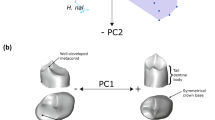Abstract
Neosaimiri fieldsi, from the South American middle Miocene locality of La Venta, is represented by a relatively complete mandible and dentition that strongly resembles that of extantSaimiri. Comparison with a large sample of mandibles ofSaimiri indicates that this specimen cannot be distinguished from modern populations on the basis of any reportedly diagnostic feature, such as cingulid development, molar length ratio, trigonic/talonid ratio, or mandibular depth. The fossil is best considered an extinct species of the modern genusSaimiri until further material indicates otherwise.
Similar content being viewed by others
References
Delson, E., and Rosenberger, A. L. (1984). Are there any anthropoid primate “living fossils”? In Eldredge, N., and Stanley, S. (eds.),Living Fossils, Springer-Verlag, New York, pp. 50–61.
Gebo, D. L., Dagosto, M., Rosenberger, A. L., and Setoguchi, T. (1990). New platyrrhine tali from La Venta, Colombia.J. Hum. Evol. 19: 737–746.
Hartwig, W. C., Rosenberger, A. L., and Setoguchi, T. (1990). New fossil platyrrhines from the late Oligocene and middle Miocene.Am. J. Phys. Anthropol. 81: 237.
Hershkovitz, P. (1970). Notes on Tertiary platyrrhine monkeys and description of a new genus from the late Miocene of Columbia.Folia Primatol. 12: 1–37.
Hershkovitz, P. (1984). Taxonomy of squirrel monkeys, genusSaimiri (Cebidae, Platyrrhini): A preliminary report with description of a hitherto unnamed form.Am. J. Primatol. 7: 155–210.
Hill, W. C. O. (1960).Primates. Comparative Anatomy and Taxonomy. Vol. IV. Cebidae, Part A, University of Edinburgh Press, Edinburgh.
Kay, R. F. (1989). A new small platyrrhine from the Miocene of Columbia and the phyletic position of the callitrichines.Am. J. Phys. Anthropol. 78: 251.
Kay, R. F., Madden, R. H., Plavcan, J. M., Cifelli, R. L., and Guerrero, J. (1987).Stirtonia victoriae, a new species of Miocene Columbian primate.J. Hum. Evol. 16: 173–196.
Kinzey, W. G. (1973). Reduction of the cingulum in Ceboidea. In Montagna, W. (ed.),Craniofacial Biology of the Primates, Vol. 3, Karger, Basel, pp. 101–127.
Luchterhand, K., Kay, R. F., and Madden, R. H. (1986).Mohanamico hershkovitzi, gen. et sp. nov., un primate du Miocene moyen d'Amerique du Sud.C.R. Acad. Sci. Ser. 3 303: 753–758.
Meldrum, D. J., Fleagle, J. G., and Kay, R. F. (1990). Partial humeri of two Miocene Columbian primates.Am. J. Phys. Anthropol. 81: 413–422.
Rose, K. D., and Fleagle, J. G. (1981). The fossil history of nonhuman primates in the Americans. In Coimbra-Filho, A. F., and Mittermeier, R. A. (eds.),Ecology and Behavior of Neotropical Primates, Academia Brasiliera de Ciencias, Rio de Janeiro, pp. 111–167.
Setoguchi, T., and Rosenberger, A. L. (1985). Miocene marmosets: First fossil evidence.Int. J. Primatol. 6: 615–625.
Setoguchi, T., and Rosenberger, A. L. (1987). A fossil owl monkey from La Venta, Colombia.Nature 326: 692–694.
Simons, E. L. (1972).Primate Evolution: An Introduction to Man's Place in Nature, Macmillan, New York.
Stirton, R. A. (1951). Ceboid monkeys from the Miocene of Colombia.University of California Publications in the Geological Sciences 28: 315–356.
Szalay, F. S., and Delson, E. (1979).Evolutionary History of the Primates, Academic Press, New York.
Thorington, R. W. (1985). The taxonomy and distribution of squirrel monkeys (Saimiri). In Rosenblum, L. A., and Coe, C. L. (eds.),Handbook of Squirrel Monkey Research. Plenum Press, New York, pp. 1–33.
Author information
Authors and Affiliations
Rights and permissions
About this article
Cite this article
Rosenberger, A.L., Hartwig, W.C., Takai, M. et al. Dental variability inSaimiri and the taxonomic status ofNeosaimiri fieldsi, an early squirrel monkey from La Venta, Colombia. International Journal of Primatology 12, 291–301 (1991). https://doi.org/10.1007/BF02547590
Received:
Revised:
Issue Date:
DOI: https://doi.org/10.1007/BF02547590




